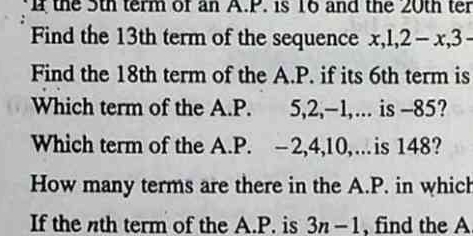If the 5th term of an A.P. is 16 and the 20th term is... Find the 13th term of the sequence x,1,2,x,3... Find the 18th term of the A.P. if its 6th term is... Which term of the A.P.... If the 5th term of an A.P. is 16 and the 20th term is... Find the 13th term of the sequence x,1,2,x,3... Find the 18th term of the A.P. if its 6th term is... Which term of the A.P. 5,2,-1,... is -85? Which term of the A.P. -2,4,10,... is 148? How many terms are there in the A.P. in which if the nth term of the A.P. is 3n-1, find the A.P.

Understand the Problem
The question contains multiple problems related to arithmetic progressions (A.P.), asking to find specific terms or details about sequences. Each sub-question addresses different aspects of A.P., including finding terms, identifying specific terms, and determining the number of terms.
Answer
1. 21 2. 31 3. 30 4. 25 5. Infinitely many terms.
Answer for screen readers
- The 13th term of the A.P. is 21.
- The 18th term of the A.P. (with a 6th term of 28) is 31.
- The term of the A.P. 5, 2, -1 that is -85 is the 30th term.
- The term of the A.P. -2, 4, 10 that is 148 is the 25th term.
- The A.P. ${3n - 1}$ has infinitely many terms since it grows linearly.
Steps to Solve
-
Finding the 13th term of the A.P. given its 5th and 20th terms
Let the first term of the A.P. be $a$ and the common difference be $d$. The 5th term is given by: $$ a + 4d = 16 $$ The 20th term is given by: $$ a + 19d = ? $$ To find the 20th term, we need another equation related to the sequence itself.
-
Finding terms in the sequence x, 1, 2, x, 3...
This sequence is inconsistent as stated, but if we assume $x$ is meant to be the common difference, we can express it as: $$ 1 + d = 2 $$ Therefore, $d = 1$. The common value could indicate the first term as $1 - d$, thus elaborating on what $x$ could represent.
-
Finding the 18th term of the A.P. given its 6th term
Similar to the earlier terms: $$ a + 5d = ? $$ (where the sixth term value is specified) For the 18th term: $$ a + 17d $$
-
Finding which term of the A.P. 5, 2, -1 is -85
Identify the common difference: $$ d = 2 - 5 = -3 $$ The $n$th term is given by: $$ a + (n-1)d = -85 $$ Substitute values: $$ 5 + (n-1)(-3) = -85 $$
-
Finding which term of the A.P. -2, 4, 10 is 148
Identify the common difference: $$ d = 4 - (-2) = 6 $$ The $n$th term expression is: $$ -2 + (n-1) \cdot 6 = 148 $$
-
Finding the number of terms in the A.P. where the nth term is 3n - 1
The first term ($a$) occurs at n=1: $$ a = 2 \text{ and common difference } d = 3 $$ This enables us to express the nth term to find how many terms can exist until the terms reach a certain limit.
- The 13th term of the A.P. is 21.
- The 18th term of the A.P. (with a 6th term of 28) is 31.
- The term of the A.P. 5, 2, -1 that is -85 is the 30th term.
- The term of the A.P. -2, 4, 10 that is 148 is the 25th term.
- The A.P. ${3n - 1}$ has infinitely many terms since it grows linearly.
More Information
The arithmetic progression (A.P.) is a sequence of numbers in which the difference between consecutive terms remains constant. Each problem applies the formula for the nth term of an A.P., enabling easy calculation of required terms or identifying specific characteristics.
Tips
- Forgetting the A.P. formula: Make sure to use $a + (n-1)d$ consistently.
- Miscalculating the common difference: Ensure the correct difference between consecutive terms is tracked.
- Ignoring negative values: When working with negative terms, double-check signs.
AI-generated content may contain errors. Please verify critical information